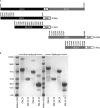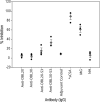Identification of VAR2CSA domain-specific inhibitory antibodies of the Plasmodium falciparum erythrocyte membrane protein 1 using a novel flow cytometry assay
- PMID: 23345587
- PMCID: PMC3592344
- DOI: 10.1128/CVI.00638-12
Identification of VAR2CSA domain-specific inhibitory antibodies of the Plasmodium falciparum erythrocyte membrane protein 1 using a novel flow cytometry assay
Abstract
VAR2CSA, a member of the Plasmodium falciparum erythrocyte membrane protein 1 (PfEMP1) family, is a leading candidate for use in vaccines to protect first-time mothers from placental malaria (PM). VAR2CSA, which is comprised of a series of six Duffy binding-like (DBL) domains, binds chondroitin sulfate A (CSA) on placental syncytiotrophoblast. Several recombinant DBL domains have been shown to bind CSA. In order to identify and develop recombinant proteins suitable for clinical development, DBL2X and DBL3X, as well as their respective third subdomain (S3) from the FCR3 parasite clone, were expressed in Escherichia coli, refolded, and purified. All but DBL3X-S3 recombinant proteins bound to CSA expressed on Chinese hamster ovary (CHO)-K1 cells but not to CHO-pgsA745 cells, which are CSA negative as determined by flow cytometry. All but DBL3X-S3 bound to CSA on chondroitin sulfate proteoglycan (CSPG) as determined by surface plasmon resonance (SPR) analysis. Purified IgG from rats and rabbits immunized with these four recombinant proteins bound homologous and some heterologous parasite-infected erythrocytes (IE). Using a novel flow cytometry inhibition-of-binding assay (flow-IBA), antibodies against DBL3X-S3 inhibited 35% and 45% of IE binding to CSA on CHO-K1 cells compared to results for soluble CSA (sCSA) and purified multigravida (MG) IgG, respectively, from areas in Tanzania to which malaria is endemic. Antibodies generated against the other domains provided little or no inhibition of IE binding to CSA on CHO-K1 cells as determined by the flow cytometry inhibition-of-binding assay. These results demonstrate for the first time the ability to identify antibodies to VAR2CSA DBL domains and subdomains capable of inhibiting VAR2CSA parasite-IE binding to CSA by flow cytometry. The flow cytometry inhibition-of-binding assay was robust and provided an accurate, reproducible, and reliable means to identify blocking of IE binding to CSA and promises to be significant in the development of a vaccine to protect pregnant women.
Figures






Similar articles
-
Subdomain 3 of Plasmodium falciparum VAR2CSA DBL3x is identified as a minimal chondroitin sulfate A-binding region.J Biol Chem. 2010 Aug 6;285(32):24855-62. doi: 10.1074/jbc.M110.118612. Epub 2010 Jun 7. J Biol Chem. 2010. PMID: 20529864 Free PMC article.
-
Antibodies to Escherichia coli-expressed C-terminal domains of Plasmodium falciparum variant surface antigen 2-chondroitin sulfate A (VAR2CSA) inhibit binding of CSA-adherent parasites to placental tissue.Infect Immun. 2013 Apr;81(4):1031-9. doi: 10.1128/IAI.00978-12. Epub 2013 Jan 14. Infect Immun. 2013. PMID: 23319559 Free PMC article.
-
Full-length recombinant Plasmodium falciparum VAR2CSA binds specifically to CSPG and induces potent parasite adhesion-blocking antibodies.J Mol Biol. 2010 Apr 2;397(3):826-34. doi: 10.1016/j.jmb.2010.01.040. Epub 2010 Jan 25. J Mol Biol. 2010. PMID: 20109466 Free PMC article.
-
Differential adhesion-inhibitory patterns of antibodies raised against two major variants of the NTS-DBL2X region of VAR2CSA.Vaccine. 2013 Sep 23;31(41):4516-22. doi: 10.1016/j.vaccine.2013.07.072. Epub 2013 Aug 9. Vaccine. 2013. PMID: 23933341
-
Designing a VAR2CSA-based vaccine to prevent placental malaria.Vaccine. 2015 Dec 22;33(52):7483-8. doi: 10.1016/j.vaccine.2015.10.011. Epub 2015 Nov 26. Vaccine. 2015. PMID: 26469717 Free PMC article. Review.
Cited by
-
3D microfluidics-assisted modeling of glucose transport in placental malaria.Sci Rep. 2022 Sep 10;12(1):15278. doi: 10.1038/s41598-022-19422-y. Sci Rep. 2022. PMID: 36088464 Free PMC article.
-
Aotus nancymaae model predicts human immune response to the placental malaria vaccine candidate VAR2CSA.Lab Anim (NY). 2023 Dec;52(12):315-323. doi: 10.1038/s41684-023-01274-2. Epub 2023 Nov 6. Lab Anim (NY). 2023. PMID: 37932470 Free PMC article.
-
Utilizing nanobody technology to target non-immunodominant domains of VAR2CSA.PLoS One. 2014 Jan 21;9(1):e84981. doi: 10.1371/journal.pone.0084981. eCollection 2014. PLoS One. 2014. PMID: 24465459 Free PMC article.
-
Cytoadhesion of Plasmodium falciparum-infected erythrocytes to chondroitin-4-sulfate is cooperative and shear enhanced.Blood. 2015 Jan 8;125(2):383-91. doi: 10.1182/blood-2014-03-561019. Epub 2014 Oct 28. Blood. 2015. PMID: 25352129 Free PMC article.
-
Functional Antibodies against Placental Malaria Parasites Are Variant Dependent and Differ by Geographic Region.Infect Immun. 2019 Jun 20;87(7):e00865-18. doi: 10.1128/IAI.00865-18. Print 2019 Jul. Infect Immun. 2019. PMID: 30988054 Free PMC article.
References
-
- Baruch DI, Pasloske BL, Singh HB, Bi X, Ma XC, Feldman M. 1995. Cloning the P. falciparum gene encoding PfEMP1, a malarial variant antigen and adherence receptor on the surface of parasitized human erythrocytes. Cell 82: 77– 87 - PubMed
-
- Su XZ, Heatwole VM, Wertheimer SP, Guinet F, Herrfeldt JA, Peterson DS. 1995. The large diverse gene family var encodes proteins involved in cytoadherence and antigenic variation of Plasmodium falciparum-infected erythrocytes. Cell 82: 89– 100 - PubMed
-
- Costa FT, Avril M, Nogueira PA, Gysin J. 2006. Cytoadhesion of Plasmodium falciparum-infected erythrocytes and the infected placenta: a two-way pathway. Braz. J. Med. Biol. Res. 39: 1525– 1536 - PubMed
-
- Dellicour S, Tatem AJ, Guerra CA, Snow RW, ter Kuile FO. 2010. Quantifying the number of pregnancies at risk of malaria in 2007: a demographic study. PLoS Med. 7: e1000221 doi:10.1371/journal.pmed.1000221 - DOI - PMC - PubMed
Publication types
MeSH terms
Substances
Grants and funding
LinkOut - more resources
Full Text Sources
Other Literature Sources
Research Materials

